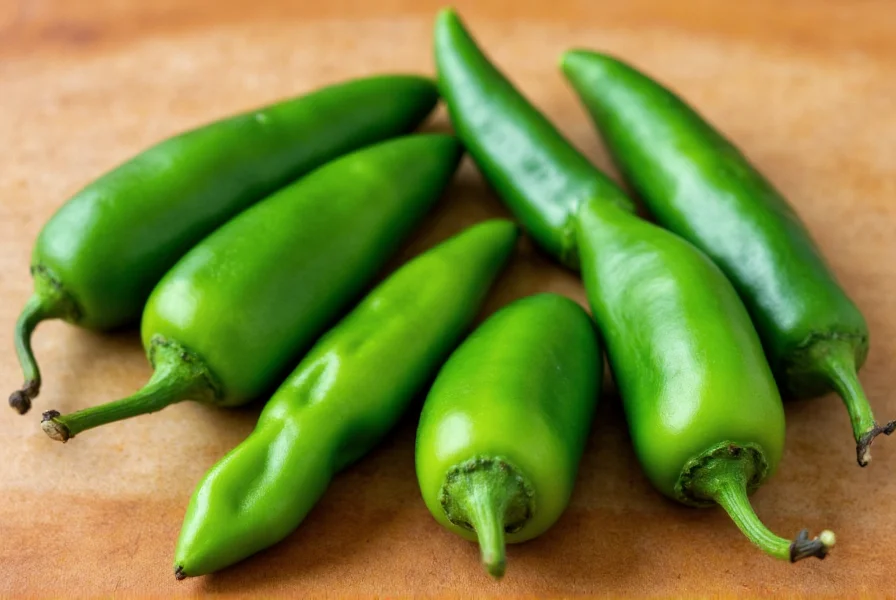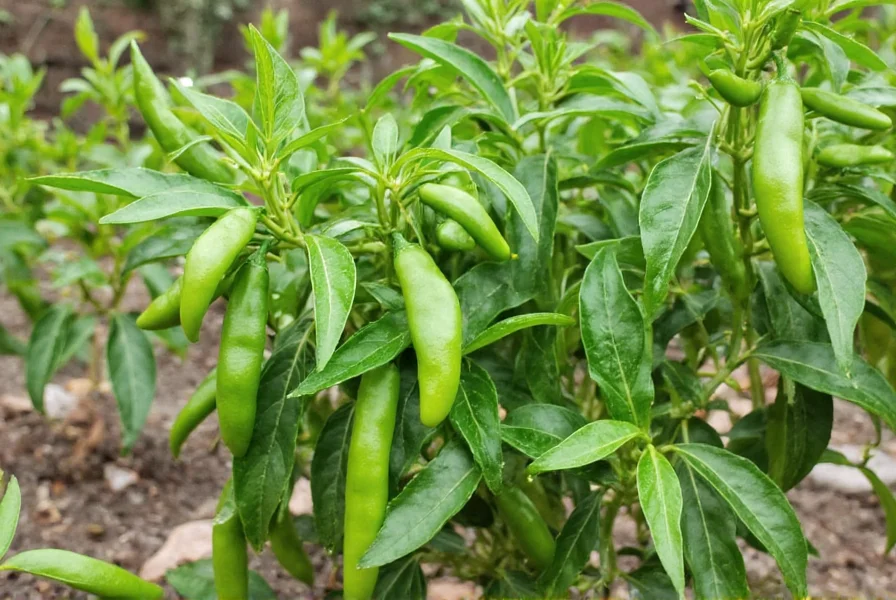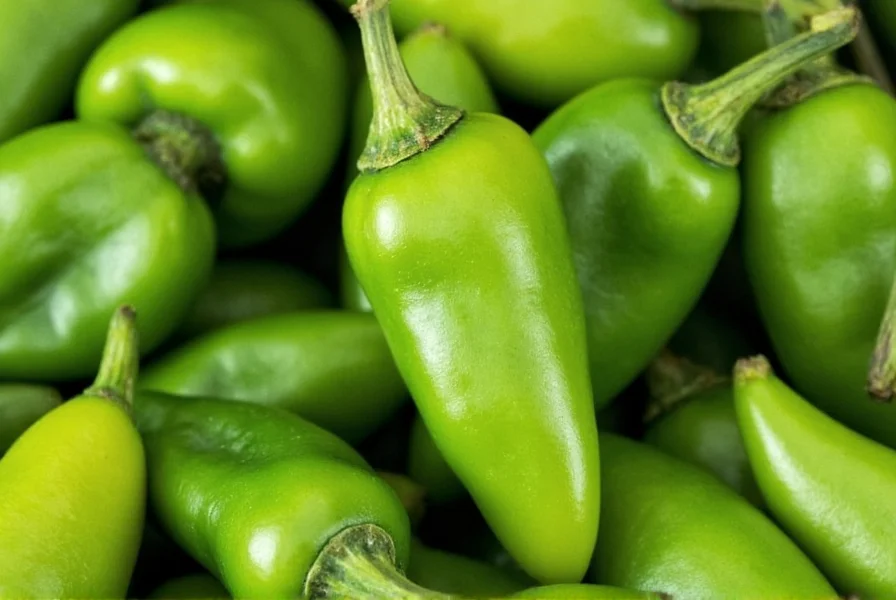A green chili pepper is an unripe fruit from the Capsicum genus, harvested before reaching full maturity. Unlike red or yellow varieties, green chilies maintain their chlorophyll-rich color due to early picking, offering a distinct grassy flavor with moderate heat ranging from 2,500-8,000 Scoville units depending on variety. These versatile peppers contain capsaicin—the compound responsible for their heat—as well as high levels of vitamin C and antioxidants.
When exploring what is a green chili pepper, it's essential to understand its botanical identity and culinary significance. Green chilies represent the immature stage of various Capsicum annuum cultivars, plucked while still firm and vibrant green. This early harvest preserves their signature crisp texture and fresh, vegetal flavor profile that distinguishes them from fully ripened counterparts.
Understanding Green Chili Pepper Characteristics
Green chili peppers serve as culinary staples across global cuisines, particularly in Mexican, Indian, and Southeast Asian cooking. Their heat level varies significantly by variety—jalapeños deliver mild warmth while serranos pack more punch. The chlorophyll content gives them their characteristic green hue, while lower sugar content compared to ripe peppers creates a sharper, more vegetal taste.
Unlike their red counterparts which develop sweeter notes through ripening, green chilies maintain a bright, acidic quality that enhances salsas, stir-fries, and stuffed pepper dishes. Their firm flesh holds up well to cooking methods like roasting, pickling, or grilling without becoming mushy.
| Pepper Variety | Heat Level (Scoville) | Flavor Profile | Common Uses |
|---|---|---|---|
| Jalapeño | 2,500-8,000 | Grassy, slightly sweet | Salsas, nachos, poppers |
| Serrano | 10,000-23,000 | Sharp, bright | Pico de gallo, hot sauces |
| Poblano | 1,000-2,000 | Earthy, mild | Chiles rellenos, mole |
| Thai Bird's Eye | 50,000-100,000 | Intensely spicy | Curry pastes, dipping sauces |
Green vs. Red Chili Peppers: Key Differences
Many people wonder what is the difference between green and red chili peppers. The color variation stems from ripeness—green peppers are harvested early, while red ones continue developing on the plant. This maturation process transforms both flavor and nutritional content.
As chilies ripen from green to red, their sugar content increases while chlorophyll breaks down, creating sweeter, fruitier flavors with deeper color. Red peppers typically contain higher vitamin A levels, while green varieties maintain superior vitamin C content. The heat level often intensifies slightly during ripening, though this varies by cultivar.
Culinary Applications of Green Chili Peppers
Chefs value green chili peppers for their ability to add complex heat without overwhelming sweetness. When considering how to use fresh green chili peppers, remember these techniques:
- Roasting: Char over open flame to develop smoky depth while preserving texture
- Raw applications: Finely dice for salsas and salads to provide fresh heat
- Stuffed preparations: Poblanos work perfectly for chiles rellenos
- Pickling: Preserves crunch while mellowing heat slightly
For home cooks exploring green chili pepper recipes, start with mild varieties like jalapeños. Remove seeds and membranes to reduce heat, or leave them intact for maximum spice. Always wash hands thoroughly after handling to avoid transferring capsaicin to sensitive areas.

Nutritional Benefits and Considerations
Green chili peppers deliver impressive nutritional advantages beyond their culinary versatility. They rank among the highest vegetable sources of vitamin C—providing over 100% of daily requirements per serving. The capsaicin content offers potential metabolic benefits and pain relief properties, though those with sensitive digestive systems should consume them in moderation.
When researching nutritional benefits of green chili peppers, note that cooking methods affect nutrient retention. Quick stir-frying preserves more vitamins than prolonged boiling. The peppers' low calorie count (about 29 calories per 100g) makes them ideal for health-conscious cooking.
Growing Your Own Green Chili Peppers
Gardeners interested in how green chili peppers grow should know these plants thrive in warm climates with well-draining soil. Most varieties require 70-80 days to maturity, but you can harvest them at the green stage weeks before full ripening. Pinch off flowers early to encourage bushier growth and higher yields.
For optimal results when growing fresh green chili peppers, provide consistent moisture without waterlogging, and harvest when peppers reach full size but remain firm and glossy green. Leaving them on the plant longer increases heat level but reduces the characteristic green pepper freshness.

Frequently Asked Questions
Are green chili peppers just unripe red peppers?
Yes, most green chili peppers are simply the unripe version of what would become red, yellow, or orange peppers if left on the plant. Harvesting at the green stage preserves their distinctive grassy flavor and firmer texture.
Why are some green chili peppers hotter than others?
Heat variation comes from genetics and growing conditions. Factors like water stress, soil nutrients, and sunlight exposure affect capsaicin production. Even within the same variety, individual peppers can show significant heat differences.
How do I reduce the heat of green chili peppers?
Remove the seeds and white membranes (placenta) where most capsaicin concentrates. Soaking chopped peppers in salt water or dairy products like milk can also neutralize some heat. Cooking methods like roasting or boiling reduce perceived spiciness.
Can I substitute green chili peppers for jalapeños?
Yes, but check heat levels first. Serranos make good jalapeño substitutes with similar flavor but more heat. Poblanos work for milder applications. Adjust quantities based on the specific pepper's Scoville rating to maintain recipe balance.
How should I store fresh green chili peppers?
Store unwashed peppers in a paper bag in the refrigerator crisper drawer for up to two weeks. For longer storage, roast and freeze them in airtight containers. Never store in plastic bags which trap moisture and accelerate spoilage.











 浙公网安备
33010002000092号
浙公网安备
33010002000092号 浙B2-20120091-4
浙B2-20120091-4